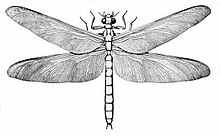巨脉蜻蜓
| 巨脉蜻蜓 化石时期:晚石炭纪
| |
|---|---|

| |
| 化石 | |

| |
| 复原图 | |
| 科学分类 | |
| 界: | 动物界 Animalia |
| 门: | 节肢动物门 Arthropoda |
| 纲: | 昆虫纲 Insecta |
| 目: | †巨差翅目 Meganisoptera |
| 科: | †巨脉科 Meganeuridae |
| 属: | †巨脉属 Meganeura |
| 种 | |
| |
巨脉蜻蜓(学名:Meganeura),又名大尾蜻蜓或巨尾蜻蜓,是3亿年前石炭纪的一种已灭绝昆虫,外型与现今的蜻蜓接近,两者有亲缘关系。翼展范围自 65 cm(25.6英寸) 到超过 70 cm(28英寸)[1][2],是目前已知地球上曾出现最大的飞行昆虫。牠们是掠食者,以其他昆虫及细小的两栖动物为食物。
巨脉蜻蜓的化石是于1880年在法国科芒特里的煤矿场发现。法国古生物学家查理斯·布隆尼亚则于 1885 年将化石命名为 Meganeura,意思为“巨大的网脉”,指的是化石上清晰的网状翅脉。另一个完整的化石标本是于1979年在德比郡的博尔索弗发现。完模标本现存放在巴黎的法国国立自然史博物馆。
体型
有多项理论可能可以解释石炭纪昆虫的巨大体型,但仍然具有争议:
- 氧气浓度与大气密度:昆虫透过气管将氧气扩散至全身,而这项系统会限制牠们的体型,但史前昆虫却能突破这项限制。最早的理论(Harlé & Harlé, 1911)认为当时的空气中氧气含量远高于现今的 20% 才能造就如此巨大的体型。这项理论最初不被其他科学家接纳,但是近年的研究却证实了氧气浓度与巨人症的关联性,更高的氧气浓度可以促使昆虫长成更大的体型[3]。若这项理论正确,则之后氧气含量的下跌可能就是这些巨型昆虫灭绝的主因。反对这项理论的科学家则认为,昆虫的气管系统也会透过主动扩张与收缩来涉入氧气,不仅仅是透过被动式的扩散,因此不会是限制牠们体型的主因[4]。最近针对现存昆虫与鸟类的飞行力能学的研究分析显示氧气浓度与大气密度的确会限制这些飞行生物的体型[5]。二叠纪时期虽然氧气含量较石炭纪大幅下降,但仍有巨脉科的物种拥有接近巨脉蜻蜓的翼展,这项结果驳斥了先前对于氧气浓度与昆虫体型相关的理论。此外,尽管巨脉蜻蜓具有目前已知最大飞行昆虫的翼展,牠们的身体却不大,体重甚至小于部分现今的鞘翅目,这代表着巨脉蜻蜓可能并不是真正的巨型昆虫,而仅仅只是较现存的近亲大型而已。
- 缺乏掠食者:另外一项理论认为拿巨脉蜻蜓的巨大体型与现存近亲做比较无任何意义[6]。科学家(Bechly, 2004)认为当时缺乏会飞行的脊椎动物掠食者才导致了这些生存于石炭纪与二叠纪时期有翅亚纲的昆虫得以长到体型上限。而在肉食性魁翅目与植食性古网翅目之间的演化军备竞赛则加速了双方体型的演化速度[7]。
- 水生幼虫竞争:还有一项理论认为在水中发育成长的陆生昆虫,在幼体时期必须有巨大的体型以适应当时高浓度的氧气[8]。
参考
- ^ Rake 2017,第20页.
- ^ Taylor & Lewis 2007,第160页.
- ^ Chapelle, Gauthier; Peck, Lloyd S. Polar gigantism dictated by oxygen availability. Nature. 1999-05, 399 (6732) [2022-10-07]. ISSN 1476-4687. doi:10.1038/20099. (原始内容存档于2017-06-07) (英语).
- ^ Westneat, Mark W.; Betz, Oliver; Blob, Richard W.; Fezzaa, Kamel; Cooper, W. James; Lee, Wah-Keat. Tracheal Respiration in Insects Visualized with Synchrotron X-ray Imaging. Science. 2003-01-24, 299 (5606) [2022-10-07]. ISSN 0036-8075. PMID 12543973. doi:10.1126/science.1078008. (原始内容存档于2022-10-09) (英语).
- ^ Dudley, R. Atmospheric oxygen, giant Paleozoic insects and the evolution of aerial locomotor performance. The Journal of Experimental Biology. 1998-04, 201 (Pt 8) [2022-10-07]. ISSN 0022-0949. PMID 9510518. doi:10.1242/jeb.201.8.1043. (原始内容存档于2022-10-10).
- ^ G., Nel, A. Fleck, G. Garrouste, R. Gand,. The Odonatoptera of the Late Permian Lodève Basin (Insecta). OCLC 756365068.
- ^ Bechly G. (2004): Evolution and systematics. pp. 7-16 in Hutchins M., Evans A.V., Garrison R.W. and Schlager N. (eds): Grzimek's Animal Life Encyclopedia. 2nd Edition. Volume 3, Insects. 472 pp. Gale Group, Farmington Hills, MI PDF (页面存档备份,存于互联网档案馆)
- ^ Than, Ker. Why Giant Bugs Once Roamed the Earth. National Geographic. August 9, 2011 [20 July 2017]. (原始内容存档于2018-05-29).
外部链接
| ||||||||||||||||||||||||||||||||||||||||||||||||||||||||||||||||
|
Text is available under the CC BY-SA 4.0 license; additional terms may apply.
Images, videos and audio are available under their respective licenses.


